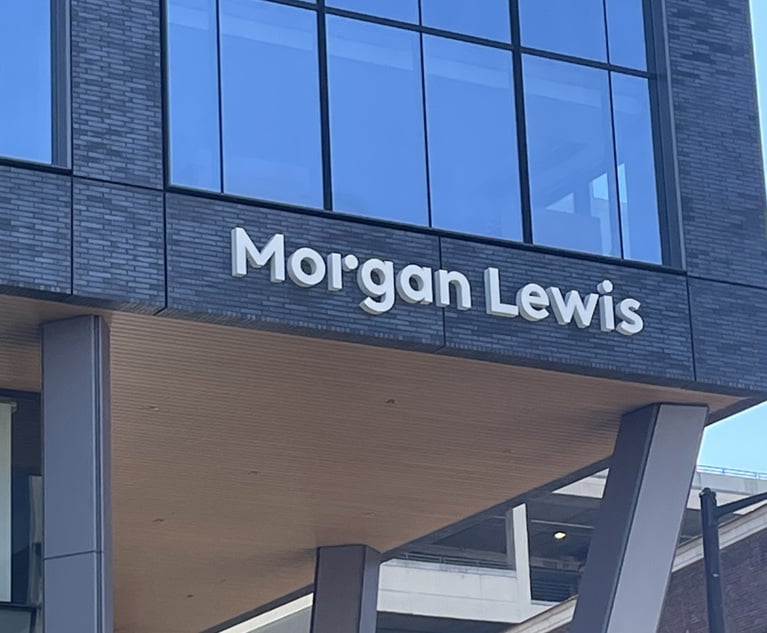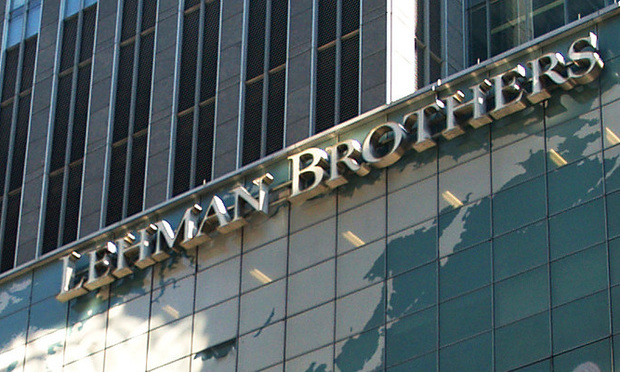A September to remember: lawyers in the eye of the storm look back on the fall of Lehman
Ten years on from the collapse of Lehman, partners from firms including Linklaters, Freshfields and Sullivan recall what it was like to be on the front lines as the financial crisis unfolded
September 17, 2018 at 03:43 AM
11 minute read
The original version of this story was published on Law.com
"Do you remember?" ask Earth, Wind and Fire in their classic hit September. For anyone who was working in the City on the morning of Monday 15 September 2008, the answer is definitely yes.
At 7.54am – six minutes before the London market opened – Lehman Brothers International Europe (LBIE) and three other Lehman companies went into administration. The largest bankruptcy filing in history would precipitate the global financial crisis. For the lawyers involved, they do not just remember, the minutiae of events leading up to that moment are seared into their minds.
During the previous week, after writing down $5.6bn on toxic mortgages, Lehman had posted a $3.9bn third-quarter loss. Nevertheless, as Freshfields Bruckhaus Deringer insolvency partner Nick Segal recalls: "There was a continuing drumbeat of disbelief – the general view prevailed that it was inconceivable that Lehman would be allowed to fail; there would be a rescue, one way or another."
A recent precedent had shown the way. On 14 March 2008, the Federal Reserve Bank of New York extended a $25bn loan to keep Bear Stearns afloat, when its exposure to subprime mortgage debt became evident. Two days later, Bear Stearns signed a merger agreement with JPMorgan Chase.
 Sullivan & Cromwell senior chairman Rodgin Cohen, who helped Bear Stearns secure the Fed deal, had emergency talks in early September with then US Treasury Secretary, Henry Paulson, and US Federal Reserve Chairman, Ben Bernanke. On behalf of mortgage giants Fannie Mae and Freddie Mac, he helped to broker a deal in Washington DC that put them under federal conservatorship. Naturally, Lehman turned to him for help.
Sullivan & Cromwell senior chairman Rodgin Cohen, who helped Bear Stearns secure the Fed deal, had emergency talks in early September with then US Treasury Secretary, Henry Paulson, and US Federal Reserve Chairman, Ben Bernanke. On behalf of mortgage giants Fannie Mae and Freddie Mac, he helped to broker a deal in Washington DC that put them under federal conservatorship. Naturally, Lehman turned to him for help.
"The Bear Stearns fire had been extinguished and Fannie was smouldering," says Cohen. But, like Segal, he was optimistic that Lehman would be rescued, for several reasons. "One, I thought the uncertainty into which the financial world would be plunged was very difficult to imagine; two, we had a successful model for the rescue of an investment bank in Bear; and three, there was at least one potential purchaser, and by September, there were two," he explains.
Although it seemed likely that Lehman would be taken over – either by Bank of America (BoA) or by Barclays Capital – London lawyers were being instructed, just in case. As he was about to get into a taxi headed for an urgent meeting with Peter Sherratt, European general counsel of LBIE, Segal got a call from Freshfields senior partner Will Lawes. Lawes told him that the firm had, earlier that day, been asked to advise the Bank of England on the matter. The conflict meant that his taxi swiftly diverted to Threadneedle Street rather than Lehman's office in Bank Street.
A troubled week culminated in a frantic weekend of negotiations on Wall Street. In London, LBIE had already contacted Silk Street to instruct Linklaters. On Thursday 11 September, David Ereira, then a partner at Linklaters [Ereira joined Paul Hastings in 2015], had received a call from Sherratt. The message was clear: the London directors of LBIE were very concerned about the lack of communication from Lehman New York. "So we gave them a one-page note on directors' duties," says Ereira. "By Saturday morning, Lehman was saying: it's looking a bit serious, can you help?"
On Saturday one of my banking partners asked: how do we put an investment bank into administration if we have to do it by Monday morning?
"We thought: if this were to blow, who on earth would we want to have do this? Our team had worked closely with Tony Lomas, Steve Pearson and others at PwC on Enron and MG Rover – big insolvencies. But we didn't know what the insolvency of an investment bank would look like, except that it would be pretty horrible." He called Lomas, who was in his swimming pool, and asked: "Just a warning call – are you technically in conflict on Lehman?" Lomas replied: "Don't worry, we've already done it." Ereira adds: "Sensible accountants plan ahead: they make sure they're not conflicted."
Linklaters insolvency partner Euan Clarke recalls his weekend. "Early on Saturday, I'd been out shopping for an engagement ring for my then fiancee, now wife. I returned to a message from one of my banking partners, Richard Holden. He was asking: how do we put an investment bank into administration if we have to do it by Monday morning? To which my honest answer was: gulp; and the second answer was: can you give me a bit of time to think?"
"After consulting my insolvency statute book, which I rather sadly keep at home, you look up 'Investment bank, administration of' in the index, and find no entries. So, we were dealing with a normal administration (which would be slightly different if it were to happen today). If it was going to go, it would be a court process, so we would need a judge."
Barristers at leading insolvency chambers South Square were retained. "Linklaters wanted William Trower QC and me to be on call for a potential high-profile administration application," recalls Daniel Bayfield QC. "Was I available over the weekend? Putting two and two together and realising what it was likely to be, I said: "Yes, of course."
Meanwhile, potential deals with either BoA or Barclays were falling apart. BoA did a deal to take over Merrill Lynch instead while Barclays was being thwarted by political pressure, as Cohen explains: "The news was delivered to us around noon (New York time). I felt shock and dismay. No one had suggested that there was a problem with the UK Government. In an extraordinarily tumultuous time, there was a failure to communicate. The government had serious problems with Barclays coming in, so they didn't. It came as a total surprise, and there was no Plan B."
I'm sure you've tried to construct a firebreak; but what we have here is a raging forest fire
Cohen spent his Sunday at the Fed in Liberty Street. He put in a final call to Lehman chairman and CEO Dick Fuld (known as the Gorilla of Wall Street), who was three miles away in Times Square, to deliver the news: the UK Government had refused to allow Barclays to rescue Lehman without a guarantee from the US Government. "I was desperately trying to get the US Government to consider a Plan B," says Cohen. "I said: 'I'm sure you've tried to construct a firebreak; but what we have here is a raging forest fire. No matter how deep and wide the firebreak, it's very easy for sparks to get across.'" The US authorities declined to offer a bailout: Lehman would be allowed to fail.
 Ereira (pictured) flew from Monaco to London. "Negotiations in New York had failed," he says. "The London bank needed liquidity to hit it on Sunday night for the opening of trading on Monday morning. We realised it wouldn't." As he headed for Bank Street to join forces with Sherratt and Lomas's PwC team, Clarke, Bayfield and others were piling in to Silk Street for what would be a very long night.
Ereira (pictured) flew from Monaco to London. "Negotiations in New York had failed," he says. "The London bank needed liquidity to hit it on Sunday night for the opening of trading on Monday morning. We realised it wouldn't." As he headed for Bank Street to join forces with Sherratt and Lomas's PwC team, Clarke, Bayfield and others were piling in to Silk Street for what would be a very long night.
"Our meeting room suite here, and the equivalent on the 31st floor at 25 Bank Street, was full of people in different rooms doing different things," says Clarke. "After getting my first choice of counsel in Daniel and William Trower, my second call was to find out who was the duty judge should we need to get them out of bed – to which the answer was: Mr Justice Henderson."
He explains the challenges: "On Enron, we'd had six to eight weeks to prepare for administration filings as part of the contingency planning. Lehman was many times the size and complexity. By the time we started putting pen to paper, we had less than 24 hours to do the same job on a grander scale.
"We were very fortunate to call upon a lot of people with real expertise in the sector – of the regulatory regime, of the financial products, and of Lehman Brothers as an institution. We needed to get answers to a host of questions immediately: What are the main trading companies? Which are the entities which need to be put into administration so that the administrators would have effective control when they were appointed? So that they could go in and start when it was winding down, trading off the book, dealing with employees, regulators, stock exchanges and clearing houses?"
Bayfield arrived early afternoon. Unlike Cohen, who later managed to pop home for a quick shower (at 3.30am New York time) before returning to the Fed, he, Clarke and several dozen lawyers were permanently ensconced in Silk Street until mid-morning the following day. "The reason we needed to act," explains Bayfield, "was because the Lehman Brothers Holding company (LBH) had a treasury function: it controlled the purse strings of the group, all of the money was swept into New York overnight. And so LBIE's problem was that it wouldn't have funds to settle its trades on Monday morning if LBH didn't put it in funds. That prompted the administration."
Clarke picks up the thread. "I was primarily involved in getting the companies ready to go into administration," he says, "drafting papers, gathering information, putting together detailed witness statements with all the evidence the judge would want to know to ensure it was the right thing for him to make the orders: it would be a pretty monumental decision for him.
"As the hours and minutes ticked by, and administration became more likely, the enormity of getting there by 8am hit home: a ridiculously demanding task, but it was also only the tip of the iceberg. There was, in a few people's minds, the thought: can we really get there, are we going to be in a position to meet this deadline, and are we going to be able to manage things as effectively as we would like in a process of this size and complexity? But the view was taken: if we can't do it, who can? We're as well placed as any law firm could be."
Bayfield adds: "In the early hours, we were told that LBH was going to go into Chapter 11. We continued to prepare the application papers and communicated with the judge that we would need him to come first thing in the morning before markets opened, to make the order." Mr Justice Henderson arrived at Linklaters just before 6am.
"We had the hearing in a boardroom," says Bayfield. "I remained in the same pair of jeans which I'd been wearing on Sunday afternoon. It was very difficult – with no pre-planning – to work out precisely which companies needed to go into an insolvency process from the web of European Lehman companies, and to be able to explain to the court why this was necessary and what it was that we thought we would be able to achieve."
By 7.54 am on Monday, Mr Justice Henderson had made the necessary orders. The administration process was underway. That afternoon, Simmons & Simmons held a two-hour conference call for a swathe of LBIE clients: there were more than 500 dial-ins from around the world. "We had clients some who were mainly interested because they had assets parked at Lehman – in excess of 200 hedge fund clients – and we were trying to get them released, and other clients who were going to be debtors with trade positions," explains Simmons insolvency partner Peter Manning.
A deluge of Lehman-related litigation followed. In the intervening decade, hundreds of lawyers have been involved from multiple law firms. A multibillion-pound surplus eventually emerged from LBIE, post-administration, creating further 'waterfall' litigation. The US arm of Lehman has been less fortunate; litigation continues.
Worldwide, regulation has flourished, transparency has increased and bank balance sheets have been bolstered, even if some argue strongly that not enough has yet been done to avoid a repeat. But although Lehman Brothers failed, was the response that followed a success?
"Yes," says Clarke. "By 2014, LBIE paid its creditors 100p in the pound with a £7bn surplus left over – that is very unusual. It's down to a huge number of factors, including the success of the administration process, the administrators' approach, and success through the use of the numerous court proceedings."
Cohen concurs: "In my view, absolutely, with the key exception that it would have been far better to use more money to try and deal with the individuals who were so harmed. But that was political, and there are those who maintain you never could have got the necessary authorisation from the US Congress."
This content has been archived. It is available through our partners, LexisNexis® and Bloomberg Law.
To view this content, please continue to their sites.
Not a Lexis Subscriber?
Subscribe Now
Not a Bloomberg Law Subscriber?
Subscribe Now
NOT FOR REPRINT
© 2025 ALM Global, LLC, All Rights Reserved. Request academic re-use from www.copyright.com. All other uses, submit a request to [email protected]. For more information visit Asset & Logo Licensing.
You Might Like
View All
Trump's Second Term Spurs Unusual Alliances Between US and European Law Firms
3 minute read
Goodwin to Launch Brussels Office With Quinn Emanuel Antitrust Partner
3 minute read
Trending Stories
Who Got The Work
J. Brugh Lower of Gibbons has entered an appearance for industrial equipment supplier Devco Corporation in a pending trademark infringement lawsuit. The suit, accusing the defendant of selling knock-off Graco products, was filed Dec. 18 in New Jersey District Court by Rivkin Radler on behalf of Graco Inc. and Graco Minnesota. The case, assigned to U.S. District Judge Zahid N. Quraishi, is 3:24-cv-11294, Graco Inc. et al v. Devco Corporation.
Who Got The Work
Rebecca Maller-Stein and Kent A. Yalowitz of Arnold & Porter Kaye Scholer have entered their appearances for Hanaco Venture Capital and its executives, Lior Prosor and David Frankel, in a pending securities lawsuit. The action, filed on Dec. 24 in New York Southern District Court by Zell, Aron & Co. on behalf of Goldeneye Advisors, accuses the defendants of negligently and fraudulently managing the plaintiff's $1 million investment. The case, assigned to U.S. District Judge Vernon S. Broderick, is 1:24-cv-09918, Goldeneye Advisors, LLC v. Hanaco Venture Capital, Ltd. et al.
Who Got The Work
Attorneys from A&O Shearman has stepped in as defense counsel for Toronto-Dominion Bank and other defendants in a pending securities class action. The suit, filed Dec. 11 in New York Southern District Court by Bleichmar Fonti & Auld, accuses the defendants of concealing the bank's 'pervasive' deficiencies in regards to its compliance with the Bank Secrecy Act and the quality of its anti-money laundering controls. The case, assigned to U.S. District Judge Arun Subramanian, is 1:24-cv-09445, Gonzalez v. The Toronto-Dominion Bank et al.
Who Got The Work
Crown Castle International, a Pennsylvania company providing shared communications infrastructure, has turned to Luke D. Wolf of Gordon Rees Scully Mansukhani to fend off a pending breach-of-contract lawsuit. The court action, filed Nov. 25 in Michigan Eastern District Court by Hooper Hathaway PC on behalf of The Town Residences LLC, accuses Crown Castle of failing to transfer approximately $30,000 in utility payments from T-Mobile in breach of a roof-top lease and assignment agreement. The case, assigned to U.S. District Judge Susan K. Declercq, is 2:24-cv-13131, The Town Residences LLC v. T-Mobile US, Inc. et al.
Who Got The Work
Wilfred P. Coronato and Daniel M. Schwartz of McCarter & English have stepped in as defense counsel to Electrolux Home Products Inc. in a pending product liability lawsuit. The court action, filed Nov. 26 in New York Eastern District Court by Poulos Lopiccolo PC and Nagel Rice LLP on behalf of David Stern, alleges that the defendant's refrigerators’ drawers and shelving repeatedly break and fall apart within months after purchase. The case, assigned to U.S. District Judge Joan M. Azrack, is 2:24-cv-08204, Stern v. Electrolux Home Products, Inc.
Featured Firms
Law Offices of Gary Martin Hays & Associates, P.C.
(470) 294-1674
Law Offices of Mark E. Salomone
(857) 444-6468
Smith & Hassler
(713) 739-1250










